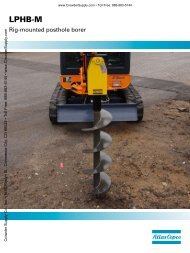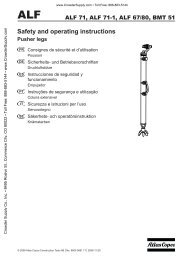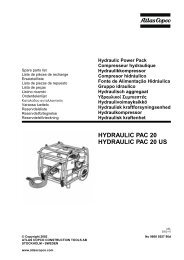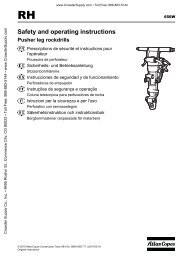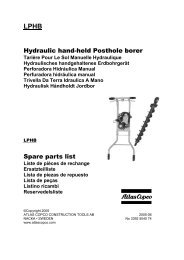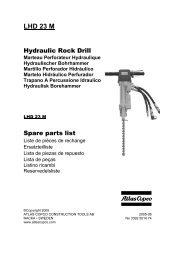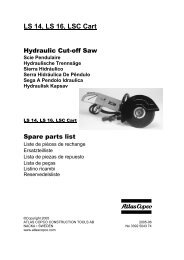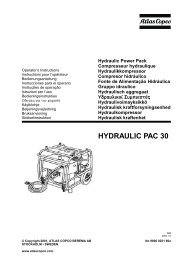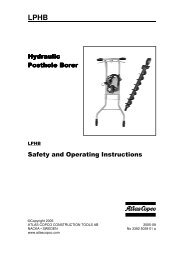Safety and operating instructions - Crowder Hydraulic Tools
Safety and operating instructions - Crowder Hydraulic Tools
Safety and operating instructions - Crowder Hydraulic Tools
Create successful ePaper yourself
Turn your PDF publications into a flip-book with our unique Google optimized e-Paper software.
ALF 72D, ALF 72D-1, ALF 67/80D, BMK 62Swww.<strong>Crowder</strong>Supply.com • Toll Free: 888-883-5144<strong>Safety</strong> <strong>and</strong> <strong>operating</strong> <strong>instructions</strong><strong>Crowder</strong> Supply Co., Inc. • 8495 Roslyn St., Commerce City, CO 80022 • Toll Free: 888-883-5144 • www.<strong>Crowder</strong>Supply.comProjectile hazardWarningDuring drilling, splinters or other particles from theworked material may become projectiles <strong>and</strong> causepersonal injury by striking the operator or otherpersons.► Use approved personal protective equipment,including impact resistant safety glasses with sideprotection, to reduce the risk of being injured by aprojectile.CautionDuring blow-cleaning particles <strong>and</strong> dirty flushing watercan emerge from the drill hole <strong>and</strong> cause personalinjury.► Move to the side <strong>and</strong> cover your eyes beforestarting to blow-clean the drill hole.► Always wear impact resistant eye protection withside protection.► Make sure that no co-workers are in range whenblow-cleaning.Noise hazardWarningHigh sound levels may cause permanent hearingloss.► Use hearing protection in accordance withoccupational health <strong>and</strong> safety regulations.Silica/Dust hazardWarningExposure to crystalline silica (sometimes called‘silica dust’) as a result of drilling, or other activitiesinvolving rock, concrete, asphalt or other materialsmay cause silicosis (a serious lung disease), silicosisrelatedillnesses, cancer, or death. Silica is a majorcomponent of rock, s<strong>and</strong> <strong>and</strong> mineral ores.To reduce silica exposure:► Use proper engineering controls to reduce theamount of silica in the air <strong>and</strong> the build-up of duston equipment <strong>and</strong> surfaces. Examples of suchcontrols include: exhaust ventilation <strong>and</strong> dustcollection systems, water sprays, <strong>and</strong> wet drilling.Make sure that controls are properly installed <strong>and</strong>maintained.► Wear, maintain, <strong>and</strong> correctly use approvedparticulate respirators when engineering controlsalone are not adequate to reduce exposure belowpermissible levels.► Participate in air monitoring, medical exams, <strong>and</strong>training programs offered by your employer <strong>and</strong>when required by law.► Wear washable or disposable protective clothes atthe worksite; shower <strong>and</strong> change into clean clothesbefore leaving the worksite to reduceexposure of silica to yourself, other persons, cars,homes, <strong>and</strong> other areas.► Do not eat, drink, or use tobacco products in areaswhere there is dust containing crystalline silica.► Wash your h<strong>and</strong>s <strong>and</strong> face before eating, drinking,or using tobacco products outside of the exposurearea.► Work with your employer to reduce silica exposureat your worksite.WarningSome dust, fumes or other airborne material createdduring use of the machine may contain chemicalsknown to the State of California to cause cancer<strong>and</strong> birth defects or other reproductive harm. Someexamples of such chemicals are:► Crystalline silica <strong>and</strong> cement <strong>and</strong> other masonryproducts.► Arsenic <strong>and</strong> chromium from chemically-treatedrubber.► Lead from lead based paints.To reduce your exposure to these chemicals, work ina well ventilated area, <strong>and</strong> work with approved safetyequipment, such as dust masks that are speciallydesigned to filter out microscopic particles.Vibration hazardWarningNormal <strong>and</strong> proper use of the machine exposes theoperator to vibration. Regular <strong>and</strong> frequent exposureto vibration may cause, contribute to, or aggravateinjury or disorders to the operator’s fingers, h<strong>and</strong>s,wrists, arms, shoulders <strong>and</strong>/or other body parts,including debilitating <strong>and</strong>/or permanent injuries ordisorders that may develop gradually over periodsof weeks, months, or years. Such injury or disordermay include damage to the blood circulatory system,damage to the nervous system, damage to joints, <strong>and</strong>possibly damage to other body structures.If numbness, tingling, pain, clumsiness, weakenedgrip, whitening of the skin, or other symptoms occurat any time, when <strong>operating</strong> the machine or whennot <strong>operating</strong> the machine, do not resume <strong>operating</strong>the machine <strong>and</strong> seek medical attention. Continueduse of the machine after the occurrence of anysuch symptom may increase the risk of symptomsbecoming more severe <strong>and</strong>/or permanent.© 2006 Atlas Copco Construction <strong>Tools</strong> AB | No. 9800 0680 71 | 2006-11-20



